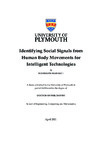Identifying Social Signals from Human Body Movements for Intelligent Technologies
| dc.contributor.supervisor | Belpaeme, Tony | |
| dc.contributor.author | Bartlett, Madeleine | |
| dc.contributor.other | School of Engineering, Computing and Mathematics | en_US |
| dc.date.accessioned | 2021-05-07T08:00:56Z | |
| dc.date.available | 2021-05-07T08:00:56Z | |
| dc.date.issued | 2021 | |
| dc.identifier | 10604483 | en_US |
| dc.identifier.uri | http://hdl.handle.net/10026.1/17095 | |
| dc.description.abstract |
Numerous Human-Computer Interaction (HCI) contexts require the identification of human internal states such as emotions, intentions, and states such as confusion and task engagement. Recognition of these states allows for artificial agents and interactive systems to provide appropriate responses to their human interaction partner. Whilst numerous solutions have been developed, many of these have been designed to classify internal states in a binary fashion, i.e. stating whether or not an internal state is present. One of the potential drawbacks of these approaches is that they provide a restricted, reductionist view of the internal states being experienced by a human user. As a result, an interactive agent which makes response decisions based on such a binary recognition system would be restricted in terms of the flexibility and appropriateness of its responses. Thus, in many settings, internal state recognition systems would benefit from being able to recognize multiple different ‘intensities’ of an internal state. However, for most classical machine learning approaches, this requires that a recognition system be trained on examples from every intensity (e.g. high, medium and low intensity task engagement). Obtaining such a training data-set can be both time- and resource-intensive. This project set out to explore whether this data requirement could be reduced whilst still providing an artificial recognition system able to provide multiple classification labels. To this end, this project first identified a set of internal states that could be recognized from human behaviour information available in a pre-existing data set. These explorations revealed that states relating to task engagement could be identified, by human observers, from human movement and posture information. A second set of studies was then dedicated to developing and testing different approaches to classifying three intensities of task engagement (high, intermediate and low) after training only on examples from the high and low task engagement data sets. The result of these studies was the development of an approach which incorporated the recently developed Legendre Memory Units, and was shown to produce an output which could be used to distinguish between all three task engagement intensities after being trained on only examples of high and low intensity task engagement. Thus this project presents the foundation work for internal state recognition systems which require less data whilst providing more classification labels. | en_US |
| dc.language.iso | en | |
| dc.publisher | University of Plymouth | |
| dc.subject | Social Signals | en_US |
| dc.subject | Engagement | en_US |
| dc.subject | Artificial Intelligence | en_US |
| dc.subject | Machine Learning | en_US |
| dc.subject.classification | PhD | en_US |
| dc.title | Identifying Social Signals from Human Body Movements for Intelligent Technologies | en_US |
| dc.type | Thesis | |
| plymouth.version | publishable | en_US |
| dc.identifier.doi | http://dx.doi.org/10.24382/1186 | |
| dc.rights.embargoperiod | No embargo | en_US |
| dc.type.qualification | Doctorate | en_US |
| rioxxterms.funder | Seventh Framework Programme | en_US |
| rioxxterms.identifier.project | DREAM 611391 | en_US |
| rioxxterms.version | NA | |
| plymouth.orcid_id | 0000-0002-2265-3120 | en_US |
Files in this item
This item appears in the following Collection(s)
-
01 Research Theses Main Collection
Research Theses Main


